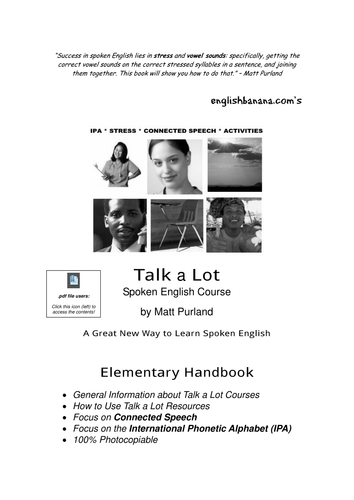

Talk a Lot - Spoken English Course - Public Domain Book
A Great New Way to Learn Spoken English
Elementary Handbook
• General Information about Talk a Lot Courses
• How to Use Talk a Lot Resources
• Focus on Connected Speech
• Focus on the International Phonetic Alphabet (IPA)
• 100% Photocopiable
This handbook shows you how to use Talk a Lot materials to learn or teach spoken English,
as well as providing background information and practice worksheets on related topics, such
as connected speech, sentence and word stress, and the International Phonetic Alphabet
(IPA).
The Talk a Lot course objectives are very simple:
• Every student talking in English
• Every student listening to and understanding English
• Every student thinking in English, and
• Every student taking part in class
Talk a Lot is structured so that every student can practise and improve English grammar,
vocabulary, pronunciation, fluency, word and sentence stress, and interpersonal skills, by
working in pairs, groups and one to one with the teacher.
The main benefits of Talk a Lot are:
• Students have to think in English during lessons in a controlled and focused way
• Students learn how to memorise correct English structures naturally, without abstract
and unrelated grammar lessons
• Students learn how to construct eight different common verb forms, using positive,
negative and question forms, as well as embedded grammar appropriate to their
level. The verb forms studied are: Present Simple, Present Continuous, Past Simple,
Past Continuous, Present Perfect, Modal Verbs, Future Forms, and First Conditional
• Students learn many essential vocabulary words by heart, including word stress and
the sounds of English
• Students learn how to become more fluent when speaking in English, by joining
together words in a sentence using the techniques of connected speech
• Students enjoy following a simple and effective method that produces results quickly.
This handbook is not intended to be an exhaustive academic work. The aim was to write a
brief, helpful guide and pack of resources that would provide a way into practise and
language work in the classroom, rather than a dry, analytical manual. For example, I have
deliberately avoided confusing jargon when writing about connected speech. Phrases like
“bilabial plosive” and “palato-alveolar approximate” – though fun to say – can be studied later,
or at the student’s leisure.
A Great New Way to Learn Spoken English
Elementary Handbook
• General Information about Talk a Lot Courses
• How to Use Talk a Lot Resources
• Focus on Connected Speech
• Focus on the International Phonetic Alphabet (IPA)
• 100% Photocopiable
This handbook shows you how to use Talk a Lot materials to learn or teach spoken English,
as well as providing background information and practice worksheets on related topics, such
as connected speech, sentence and word stress, and the International Phonetic Alphabet
(IPA).
The Talk a Lot course objectives are very simple:
• Every student talking in English
• Every student listening to and understanding English
• Every student thinking in English, and
• Every student taking part in class
Talk a Lot is structured so that every student can practise and improve English grammar,
vocabulary, pronunciation, fluency, word and sentence stress, and interpersonal skills, by
working in pairs, groups and one to one with the teacher.
The main benefits of Talk a Lot are:
• Students have to think in English during lessons in a controlled and focused way
• Students learn how to memorise correct English structures naturally, without abstract
and unrelated grammar lessons
• Students learn how to construct eight different common verb forms, using positive,
negative and question forms, as well as embedded grammar appropriate to their
level. The verb forms studied are: Present Simple, Present Continuous, Past Simple,
Past Continuous, Present Perfect, Modal Verbs, Future Forms, and First Conditional
• Students learn many essential vocabulary words by heart, including word stress and
the sounds of English
• Students learn how to become more fluent when speaking in English, by joining
together words in a sentence using the techniques of connected speech
• Students enjoy following a simple and effective method that produces results quickly.
This handbook is not intended to be an exhaustive academic work. The aim was to write a
brief, helpful guide and pack of resources that would provide a way into practise and
language work in the classroom, rather than a dry, analytical manual. For example, I have
deliberately avoided confusing jargon when writing about connected speech. Phrases like
“bilabial plosive” and “palato-alveolar approximate” – though fun to say – can be studied later,
or at the student’s leisure.
Get this resource as part of a bundle and save up to 96%
A bundle is a package of resources grouped together to teach a particular topic, or a series of lessons, in one place.
Something went wrong, please try again later.
Report this resourceto let us know if it violates our terms and conditions.
Our customer service team will review your report and will be in touch.
£0.00